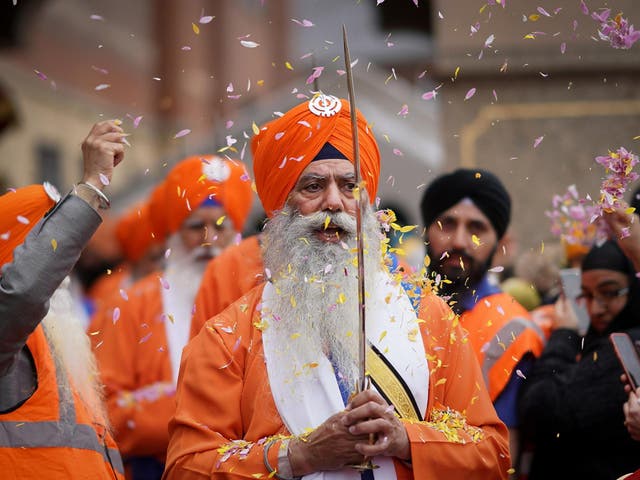Sikhism is a religion originated in the Punjab region of the Indian subcontinent around the end of the 15th century AD. It is one of the youngest of the major South Asian religions and the world’s fifth-largest organized religion, with about 25–30 million Sikhs as of the early 21st century.
Sikhism developed from the spiritual teachings of Guru Nanak, the first Guru (1469–1539), and of the nine Sikh gurus who succeeded him. The tenth guru, Gobind Singh (1666–1708), named the Sikh holy scripture Guru Granth Sahib as his successor, bringing to a close the line of human gurus and establishing the scripture as the last eternal 11th living guru, a religious, spiritual and life guide for Sikhs. Guru Nanak taught that living an “active, creative, and practical life” of “truthfulness, fidelity, self-control and purity” is above metaphysical truth, and that the ideal man “establishes union with God, knows His Will, and carries out that Will”. The founder Guru Nanak summarized this perspective as: “Truth is the highest virtue, but higher still is truthful living”. Guru Hargobind, the sixth Sikh Guru (1606–1644), established the concept of mutual co-existence of the miri (‘political’/’temporal’) and piri (‘spiritual’) realms.
The Guru Granth Sahib, the holy scripture of the Sikhs, is regarded as the living Guru. The Guru Granth started as a volume of Guru Nanak’s poetic compositions. Prior to his death, he passed on his volume to Guru Angad. The final version of the Gurū Granth Sāhib was compiled by Guru Gobind Singh in 1678. It consists of the original Ādi Granth with the addition of Guru Tegh Bahadur’s hymns. The predominant bulk of Guru Granth Sahib is compositions by seven Sikh Gurus, but it also contains the traditions and teachings of thirteen Hindu saints and two Muslim saints namely Kabir and the Sufi Sheikh Farid. The text comprises 6,000 verses which are poetically rendered and set to rhythmic ancient north Indian classical music. The bulk of the scripture is classified into sixty rāgas, with each Granth rāga subdivided according to length and author. However, the ragas are mostly not sung by Sikhs who are conversant with all the Ragas in the Guru Granth Sahib, but by Muslims or Hindus. Guru Nanak started the tradition of singing the verses of Guru Granth Sahib and taught that listening to this is a powerful way to achieve tranquillity while meditating; Singing of the glories of the Supreme Timeless One (God) with devotion is the most effective way to come in communion with the Supreme Timeless One. The main language used in the scripture is known as Sant Bhāṣā, a language related to both Punjabi and Hindi and used extensively across medieval northern India by proponents of popular devotional religion. The text is printed in Gurumukhi script
Sikhism is a monotheistic religion that advocates the belief in One God and is signified by the term Ik Onkar. In Sikhism, the overall concept of God is that He is considered to be shapeless, timeless, ‘the creator of the world and incomprehensible and invisible. In this regard Sikhism shares the concept of God with Islam. The Sikh scripture opens with the fundamental prayer about the oneness of God. The core beliefs of Sikhism, articulated in the Guru Granth Sahib, include faith and meditation in the name of the one creator; divine unity and equality of all humankind; engaging in seva (‘selfless service’); striving for justice for the benefit and prosperity of all; and honest conduct and livelihood while living a householder’s life. Following this standard, Sikhism rejects claims that any particular religious tradition has a monopoly on Absolute Truth.

Sikhism has a spiritual dimension as well; it emphasizes meditation and remembrance of the teachings of Gurus, which can be expressed musically through kirtan, or internally through naam japna (‘meditation on His name’) as a means to feel God’s presence. It teaches followers to fight and transform the “Five Thieves” (i.e. lust, rage, greed, attachment, and ego).The influences of ego, anger, greed, attachment, and lust are believed to be particularly distracting and hurtful. Sikhs believe the world is currently in a state of kali yuga (‘age of darkness’) because the world is led astray by the love of and attachment to Māyā. Māyā, another idea from Hinduism, is defined as a temporary illusion or “unreality”, is one of the core deviations from the pursuit of God and salvation: where worldly attractions give only illusory temporary satisfaction and pain that distracts from the process of the devotion of God. The fate of people vulnerable to the five thieves, is separation from God, and the situation may be remedied only after intensive and relentless devotion. The supreme purpose of human life is to reconnect with Akal (‘The Timeless One’); hence the Sikh political party Akali Dal! Sikhism regards God as the true king, the king of all kings, the one who dispenses justice through the law of karma, a retributive model and divine grace. It does not differentiate religious obligations by sex. God in Sikhism has no sex, and the Sikh scripture does not discriminate against women, nor bar them from any roles. Women in Sikhism have been in positions of leadership, including leading in wars and issued orders or hukamnamas.
Guru Nanak’s teachings are founded not on a final destination of heaven or hell, but on a spiritual union with the Akal, which results in salvation, a concept also found in Hinduism and Buddhism. Guru Gobind Singh makes it clear that human birth is obtained with great fortune, therefore one needs to be able to make the most of this life. Sikhs accept reincarnation and karma concepts found in Buddhism, Hinduism, and Jainism. The followers of Sikhism are called Sikhs. The term Sikh has its origin in the word śiṣya meaning ‘disciple’ or ‘student’. Male Sikhs generally have Singh (‘lion’) as their middle or last name, though not all Singhs are necessarily Sikhs; likewise, female Sikhs have Kaur (‘princess’) as their middle or last name. Young Sikhs have to undergo an initiation ritual. From the day of their initiation, they are known as Khalsa Amritdhari Sikhs, and they must at all times have on their bodies five Ks: kesh, uncut hair, which is kept covered usually by a Turban; kara, an iron or steel bracelet; kirpan, a dagger-like sword tucked into a belt; kachera, a cotton undergarment; and kanga, a small wooden comb. The Punjab region of the Indian subcontinent has been the historic homeland of the Sikhs, having even been ruled by the Sikhs for significant parts of the 18th and 19th centuries. Today, the Punjab state in northwest India has a majority Sikh population, and sizeable communities of Sikhs exist around the world. Many countries, such as the United Kingdom, recognize Sikhs as a designated religion on their censuses, and, as of 2020, Sikhs are considered as a separate ethnic group in the United States. The largest Sikh population in Pakistan is found in Peshawar, in the Khyber-Pakhtunkhwa, where the Pashtun law of “nanawati” (protection) spared the scale of violence which had raged across the Indus River in Punjab. Despite the longstanding tensions between the Sikh and Muslim communities in South Asia, the Pashtuns were tolerant towards the religious minority of Sikhs. There are small pockets of Sikhs in Lahore and Nankana Sahib in Punjab. Many of the Sikhs and Hindus of West Punjab and Sindh provinces of Pakistan migrated to India after the independence of Pakistan in 1947.
Contributed by:

Dr. Bettina Robotka, former Professor of South Asian Studies, Humboldt University, Berlin, Editor of the Defence Journal and a Consultant to the Pathfinder Group.





